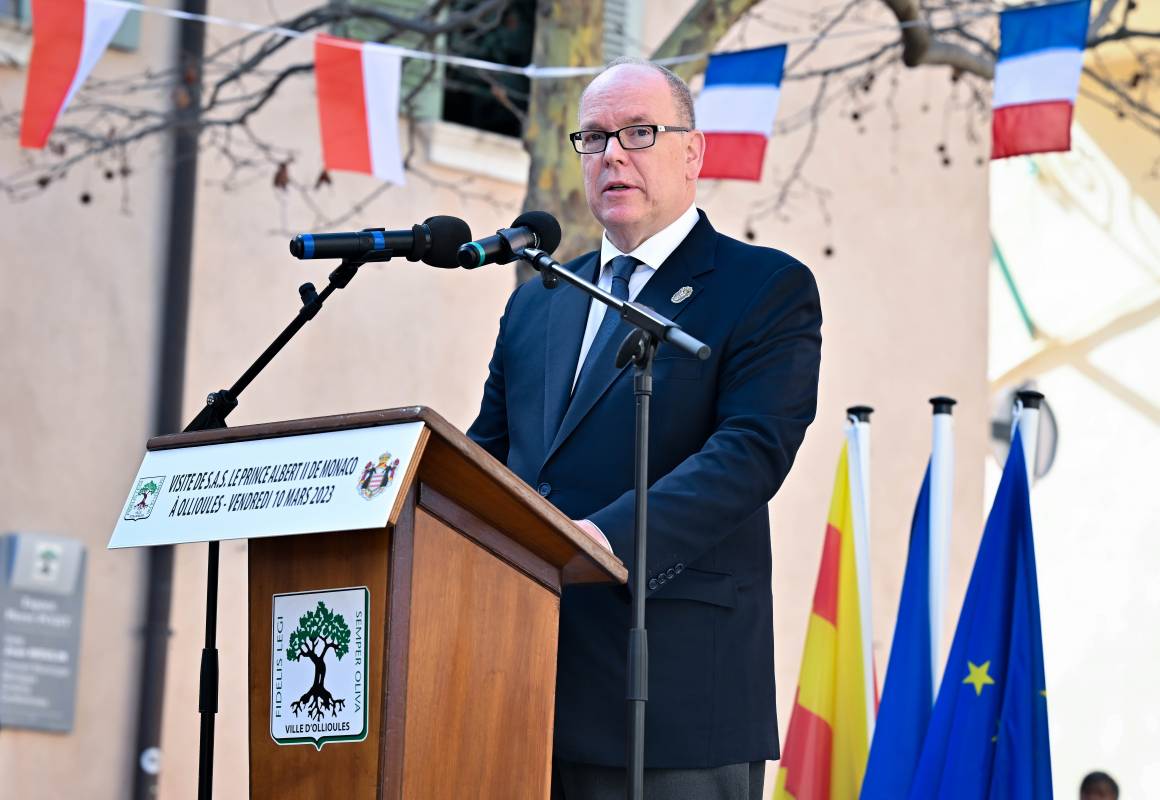Destiny works in mysterious ways. Lost and then serendipitously found, the traces of important members of the Grimaldi family surface miraculously. It’s a tale of passion and the determination of a researcher looking for detailed clues in parish registers.
In March 2023 Prince Albert II of Monaco was received with honours in Ollioules. His Serene Highness arrived to pay tribute to his distant relative whose grave was considered lost for many years. This revelation is the nugget of gold that lay hidden for 250 years to be discovered in the 21st century. A Grimaldi emerges from the depths of history…

How did this surprise revelation happen?
The historical discovery is due to the insight of Edmond Fenouillet, passionate about parish registers, emeritus member of the Research Group on the Ollioulais Heritage, who came to find Pierre-Marie Gasquy, responsible for municipal archives, with a photo of the parish register of 1770 in them and reportedly announces there is a bishop from the Grimaldi family buried in Ollioules!
The death certificate, very clear, effectively reveals the identity of a certain Jean-Charles “Charles” de Grimaldi d’Antibes, born in Cagnes in 1705 and died in Ollioules on March 10th, 1770, at the age of 65 years. On a genealogy site, Edmond Fenouillet even reportedly finds the photo of the funeral plaque — the photo dates from the 1930s — which was placed in the church of Saint-Laurent, where the prelate was buried. The plaque was subsequently lost.
Monseigneur Charles de Grimaldi d’Antibes belonged to the Grimaldi branch of the Marquis de Cagnes. He was consecrated Bishop of Rodez on September 11th, 1746 and exercised his priesthood until his death. In the winter 1770 he had come to visit his little brother, Charles de Grimaldi, whose name he also called himself by, who lived in Ollioules, where he owned the building which is today the school “Le Château”. And the Bishop had the misfortune to die in the town just some months later…
Seized by this discovery, Mayor Robert Beneventi (with Didier Martina-Fieschi, heritage assistant) then wished to put a new plaque, modelled on the old one, in the Saint-Laurent church.

Prince Albert II of Monaco in Ollioules
Prince Albert II of Monaco, illustrious representative of the last branch of the Grimaldis and very distant cousin of the Grimaldis d’Antibes, enthusiastically came to unveil a new plaque at the end of a high mass in the parish church in Ollioules on March 10th, the day of the 253rd anniversary of the death of Bishop Grimaldi.
The Sovereign also visited the “Le Château” primary school where he unveiled another plaque which commemorated His visit to the very place which, in the 18th century, was the home of Charles de Grimaldi, the younger brother of the Bishop of Rodez, who served as a squadron leader in the Navy in Toulon.
In commemoration of his visit the Prince received honorary citizenship of the town as well as a magnificent olive tree, the tree which gave the town its name.

The Origin of the Grimaldi Dynasty
Let us recall that they are the descendants of the consul of the Republic of Genoa Otto Canella (died circa 1143) and his youngest son Grimaldo (died circa 1184) who are considered as the founders of the Grimaldi dynasty. In 1297 Francesco Grimaldi, also known as “Malizia”, one of their descendants, arrived in Monaco. This was caused by the conflict between the Guelphs, supporters of the Pope, and the Ghibellines, supporters of the Romano-Germanic emperor. When, in 1270, the Ghibellines became rulers over the Genoese, the Grimaldi, who were Guelphs were exiled. Later, Francesco Grimaldi, disguised in the habit of a monk entered into the settlement of Monaco, overcoming the Genoese guards. Francesco left the governing of the fortress to his cousin Rainier, whose descendants nowadays still remain at the head of the state.
The exile of the Guelph Grimaldis played out not only in Monaco but also in France in the Var and elsewhere where the marquisal branch of Antibes of the House of Grimaldi also saw its origin. A certain Antoine Grimaldi, once Guelph admiral of the Republic of Genoa and another descendant of Otto Canella, had sons, Luc and Marc, who took possession of Cagnes (1371), Menton (1382), and Antibes (1384). This branch will give a long line who will notably combine and intermingle including by the marriage of Lambert Grimaldi d’Antibes and Claudine Grimaldi of Monaco in 1465 and played a subsequent role as a catalyst aligning the Principality with the interests of France.
And so down through history branches of the Grimaldi family would occupy powerful positions in Antibes and Cagnes all of which leads us to Charles de Grimaldi d’Antibes born in Cagnes in 1705.

Grimaldi Historic Sites
The strong connection between the Grimaldi family and Ollioules town motivated the mayor and city council to vote for membership in the French Association of Grimaldi Historic Sites. On this occasion, Prince Albert unveiled a corresponding plaque — the third one during his one-day visit.
More than a hundred communes in France and Italy share common history with the Monegasque Grimaldi dynasty. You’d be wrong to think these historical connections don’t mean much to Monaco! Far from that. The three countries, Monaco, France and Italy, constantly join their efforts in preserving this important heritage.
Since 2018, upon the initiative of Prince Albert II, a special Meeting of the Historic Sites of the Grimaldis of Monaco has been held in Monaco. Ambassadors from a number of towns and villages associated with the Grimaldis come especially to the Principality to introduce Monegasques to their culture, folklore, gastronomy, arts and crafts. This year in 2023 the 4th Meeting took place. And maybe next year master craftsmen from Ollioules will also come to Monaco to demonstrate their unique skills.

Ollioules through the centuries
Frequented by man from the Neolithic period, the territory of Ollioules was later occupied by the Celto-Ligurian tribe of the Camatulici. They created on the hill of the Courtine the largest oppidum in the region, a true fortified city which maintained commercial relations with the ancient Greeks. From that time on, the olive tree was cultivated, which would be the real emblem of the city, since it gave it its name and appears on its coat of arms.
From the Middle Ages, Ollioules (Oliolis or Oliolas) retains many vestiges, including the ruins of the feudal castle (XI–XV centuries) and its Notre-Dame du Château chapel (XII century), the Saint-Laurent church (XI–XVII century) and an important medieval core in the old town.
A large part of the current Old Town thus dates back to the XVI and XVII centuries which indeed represented a very prosperous period.

Alongside the traditional olive trees, the land is covered with orange and lemon trees. The olive tree, cultivated for the production of olive oil, has always been important. In the Middle Ages, Ollioulais oils were sold as far as Alexandria, in Egypt and later will even be found at the Court of Versailles. The flower, whose first mentions go back to the reign of Louis XIV (1643–1715), will also make the fame and the wealth of the town, in the 19th and 20th centuries.
In the 20th century, the city continued to develop. From 4,000 inhabitants at the beginning of the 20th century, it has now reached a population of nearly 14,000 inhabitants. Without giving up its authenticity as a large Provençal town, Ollioules has become a modern and dynamic place. With many workshops of craftsmen installed in the old town, it has obtained the title of “City and Crafts”.
A little nugget from History about none other than Napoleon Bonaparte
Did you know that Ollioules was the site where one of the most famous figures in history, early in his career, rose to prominence? It was in Ollioules, at the Château de Montauban, that Napoleon Bonaparte rose from a relatively lowly rank of Artillery Officer as he successfully drew up the plans in 1793 to throw the British out of Toulon and also take the city out of the hands of the Royalists.

“Bonaparte would rise to the rank of Brigadier General in recognition of his success.
I have no words to describe Bonaparte’s merit: much technical skill, an equal degree of intelligence, and too much gallantry …”
— General Jacques François Dugommier, at the siege of Toulon
Charles de Grimaldi d’Antibes
Charles or sometimes Jean-Charles Grimaldi d’Antibes is the son of Honoré III Grimaldi d’Antibes and Marguerite de Villeneuve. His family descended from the Marquis de Cagnes is a younger line of the Grimaldi family of the princes of Monaco. Charles de Grimaldi d’Antibes was born in Cagnes in 1705 and became chaplain to the king, vicar general and grand archdeacon of the archdiocese of Rouen. He was appointed bishop of Rodez in 1746.










